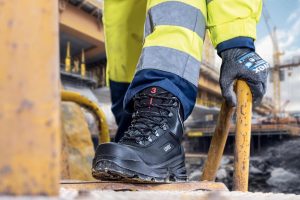Safety footwear protects against a plethora of injuries, such as impact, compression and penetration, as well as against dangerous slips and trips that can lead to bone-breaking falls. Slips and trips are the most common cause of major injuries at work, causing an estimated 1.3m lost working days in 2012/13. Supplying the correct footwear can go a long way towards reducing this toll.
Choosing effective safety footwear should take into account a number of factors, including fit, lasting comfort, flexibility, durability and any further safety features required, such as protection against chemicals or static electricity not to mention slip resistance.
The quality of materials is vital for durable performance; safety footwear should give a high level of protection, grip, support and stability, while following the natural movement of the body to reduce stress on the musculo-skeletal system.
Innovative features such as ergonomic design to lessen pressure points on the foot are important, as they are a good indication of the manufacturer’s awareness of the need to keep making improvements.
Certification in accordance with ISO 9001:2008 and EN ISO 20345 is a must, while the footwear must also be appropriate to the workplace hazard, such as sharp or pointed objects that could cut the top or penetrate the bottom or side of the foot, corrosive substances, falling objects, water, mud, chemicals or extreme heat or cold.
Extra factors
The following issues shouldn’t be ignored when procuring safety footwear:
- Prevention of fatigue, discomfort and strain on the body especially when standing; and the risk of injury
- The requirement for a lightweight but effective footwear structure
- Minimisation of heat – overheating can carry serious risks over and above causing muscle cramps and fatigue and can trigger severe, even life-threatening, conditions such as heat stroke. Specialised protective footwear such as that made with uvex climazone functions like the body’s own climatic system, keeping feet consistently at their optimum temperature of 31-32°C
- Exposure to cold – if a person’s foot temperature falls below their optimum temperature, symptoms can range from chilblains through to the most severe cold injury, hypothermia. Products that offer, fleece linings, leather and GORE-TEX to prevent water penetration, should be considered depending on the work environment and seasonal variations
- Pivot points to support rotation in the front of foot, minimise injury to joints, ease turning and increase flexibility
- Minimal seams and other manufacturing techniques to reduce pressure points and blisters and help those who may have diabetes, now increasingly common
- Gender. Women benefit by having their own anatomically-shaped female foot lasts that mimic the contours of a female foot, rather than scaled-down versions of male casts.
How the right footwear can help diabetics
It is essential that diabetics have footwear that fits properly, even if it seems comfortable. Diabetics may have poor circulation and decreased feeling in their feet but without warning pain. This can lead to diabetic foot ulcers, cuts and sores that do not heal properly and even possible alteration of foot shape owing to softened bones and nerve damage, in addition to bone fracture and amputation.
Foot health danger signs include swelling of the foot; red, hot, skin; tingling; and/or a change in the colour and shape of the foot. Pain may or may not be felt.
Effects of standing at work
Many people such as those working in construction, manufacturing, warehousing, logistics and healthcare related industries are on their feet for much of the working day. But being on their feet for prolonged periods can put many stresses and strains on feet, causing a variety of health problems and soft-tissue injuries such as inflamed feet and swollen legs. These problems occur because the muscles that hold a person upright ought to rest periodically to prevent damage to the joints and soft tissues and keep the blood flowing.
The right footwear can ameliorate these problems. Footwear must not change the shape of the foot and should be shock-absorbing. Features such as extra air bubbles in the sole, for example, will decrease impact and increase shock absorption, while reducing the weight of the boot or shoe and so lessening tension in the body.
Extra shock absorption can also be provided by special anti-fatigue insoles, which give extra support and comfort and help reduce stress and strain to the hips, knees, back and neck joints by cushioning the heel and ball of foot, so preventing tiredness from walking or long periods of standing.
Provision of the correct footwear is vital for health and safety at work. Employers should ensure safety footwear is both worn and maintained correctly, but if their employees are given comfortable, hard-wearing shoes or boots that fit well and do their job, this should not be a problem.







